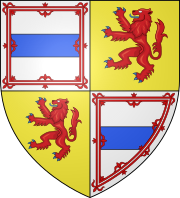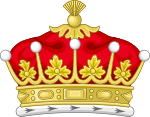Earl of Wemyss facts for kids
Quick facts for kids Earldom of Wemyssheld with Earldom of March since 1826 |
|
|---|---|

Quarterly: 1st & 4th argent, a fess, azure, within a double tressure, flory and counterflory, gules, for Charteris, 2nd and 3rd, Or, a lion rampant, gules, armed and langued azure, for Wemyss
|
|
| Creation date | 1633 (Earl of Wemyss) 1697 (Earl of March) |
| Monarch | Charles I and William III |
| Peerage | Peerage of Scotland |
| First holder | John Wemyss, 1st Earl of Wemyss William Douglas, 1st Earl of March |
| Present holder | James Charteris, 13th Earl of Wemyss and 9th Earl of March |
| Heir apparent | Richard Charteris, Lord Elcho |
| Remainder to | The 1st Earl's heirs male of the body lawfully begotten |
| Subsidiary titles | Lord Elcho Lord Neidpath Viscount Peebles |
| Seat(s) | Gosford House |
| Former seat(s) | Amisfield House Neidpath Castle Elcho Castle |
| Motto | Je Pense ("I think") |
The Earl of Wemyss (pronounced WEEMZ) is a special title in the Peerage of Scotland. This means it's a very old and important noble rank in Scotland. The Wemyss family has owned land in Wemyss in Fife, Scotland, since the 1100s.
Since 1823, the Earl of Wemyss title has been held together with another title: the Earl of March. Even though they are held by the same person, they are actually two separate titles. People sometimes call the holder the Earl of Wemyss and March.
Contents
History of the Earldom
The story of the Earls of Wemyss began in 1625. That year, John Wemyss was given the title of Baronet of Wemyss. This was a new type of noble title at the time.
A few years later, in 1628, he became Lord Wemyss of Elcho. This was a step up in the Scottish nobility. Then, in 1633, he received even more honors. He was made Lord Elcho and Methel and Earl of Wemyss.
John Wemyss supported the Scottish Parliament against King Charles I. He passed away in 1649, and his son David became the second Earl.
Changes to the Titles
In 1672, David, the second Earl, made a special agreement with the King. He gave up his titles to the Crown. In return, he received them back with a new rule. This rule meant that his daughters could inherit the titles if he had no sons.
David had no sons, so when he died in 1679, his daughter Margaret became the third Countess of Wemyss. This was unusual for the time, as titles usually passed only to sons. Margaret's son, David, later became the fourth Earl. He was an important figure, serving as the Lord High Admiral of Scotland. He also represented Scotland in the House of Lords in the British Parliament.
The fourth Earl married Lady Anne Douglas. Her brother was the first Earl of March. This connection later became very important for the Wemyss family.
Challenges and Restorations
The fifth Earl, James, had a son named David. This David, known as Lord Elcho, was involved in the Jacobite risings of 1745. These were attempts to bring the old royal family back to the throne. Because of his involvement, Lord Elcho was officially "attainted." This meant he lost his right to inherit his father's titles.
When his father died in 1756, David could not officially become the Earl. However, he still called himself the Earl of Wemyss. When he died without children, his younger brother Francis took on the title, also unofficially. Francis changed his last name to Charteris. This was because he inherited a large estate from his mother's father, Colonel Charteris.
In 1790, the family built a very large house at 64 Queen Street, Edinburgh.
Joining the Earldoms
A big change happened in 1810. William Douglas, who was the fourth Duke of Queensberry and third Earl of March, passed away. Francis Wemyss-Charteris, who was the unofficial seventh Earl of Wemyss, inherited the Earldom of March. This was because he was a direct descendant of Lady Anne Douglas, the sister of the first Earl of March.
When he gained these new titles, he changed his last name again to Charteris-Wemyss-Douglas. In 1821, he received a new title in the Peerage of the United Kingdom, called Baron Wemyss. This was a title that applied to the whole United Kingdom, not just Scotland.
Then, in 1826, a very important event happened. The "attainder" against the Earldom of Wemyss was reversed. This meant that the family's right to the title was officially restored. Francis then became the eighth Earl of Wemyss, officially holding both the Earldom of Wemyss and the Earldom of March.
Later Earls and Family Members
His son became the ninth Earl of Wemyss and fifth Earl of March. He served as the Lord-Lieutenant of Peeblesshire, a royal representative in a Scottish county. The tenth Earl was a member of the House of Commons (part of the UK Parliament) for many years.
The current holder of the titles is James Donald Charteris, the thirteenth Earl of Wemyss and ninth Earl of March. He became Earl in 2008. He is also the Chief of Clan Charteris, a Scottish clan.
Many other members of the Wemyss and Charteris families have also achieved great things. For example, Martin Michael Charles Charteris was the private secretary to Queen Elizabeth II. He was later given a special title as Baron Charteris of Amisfield.
The main home of the family is Gosford House in East Lothian, Scotland. They also own Stanway House in Gloucestershire, England, and two historic castles in Scotland: Neidpath Castle and Elcho Castle.
Earls of Wemyss (1633)
- John Wemyss, 1st Earl of Wemyss (died 1649)
- David Wemyss, 2nd Earl of Wemyss (1610–1679)
- Margaret Wemyss, 3rd Countess of Wemyss (1659–1705)
- David Wemyss, 4th Earl of Wemyss (c. 1678–1720)
- James Wemyss, 5th Earl of Wemyss (1699–1756)
- David Wemyss, soi disant 6th Earl of Wemyss (1721–1787) (lost title in 1746)
- Francis Wemyss Charteris, soi disant 7th Earl of Wemyss (1723–1808)
- Francis Wemyss Charteris Douglas, 8th Earl of Wemyss, 4th Earl of March (1772–1853) (title restored in 1826)
- Francis Wemyss-Charteris, 9th Earl of Wemyss, 5th Earl of March (1795–1883)
- Francis Richard Charteris, 10th Earl of Wemyss, 6th Earl of March (1818–1914)
- Hugo Richard Charteris, 11th Earl of Wemyss, 7th Earl of March (1857–1937)
- (Francis) David Charteris, 12th Earl of Wemyss, 8th Earl of March (1912–2008)
- James Donald Charteris, 13th Earl of Wemyss, 9th Earl of March (born 1948)
The person who is expected to inherit the titles next is the current Earl's son, (Francis) Richard Charteris, Lord Elcho (born 1984).
Earls of March (1697)
- William Douglas, 1st Earl of March (c. 1665–1705)
- William Douglas, 2nd Earl of March (c. 1696–1731)
- William Douglas, 4th Duke of Queensberry, 3rd Earl of March (1725–1810)
- Francis Wemyss Charteris Douglas, 8th Earl of Wemyss, 4th Earl of March (1772–1853)
The succession continues as listed above for the Earls of Wemyss.
Images for kids
See also





